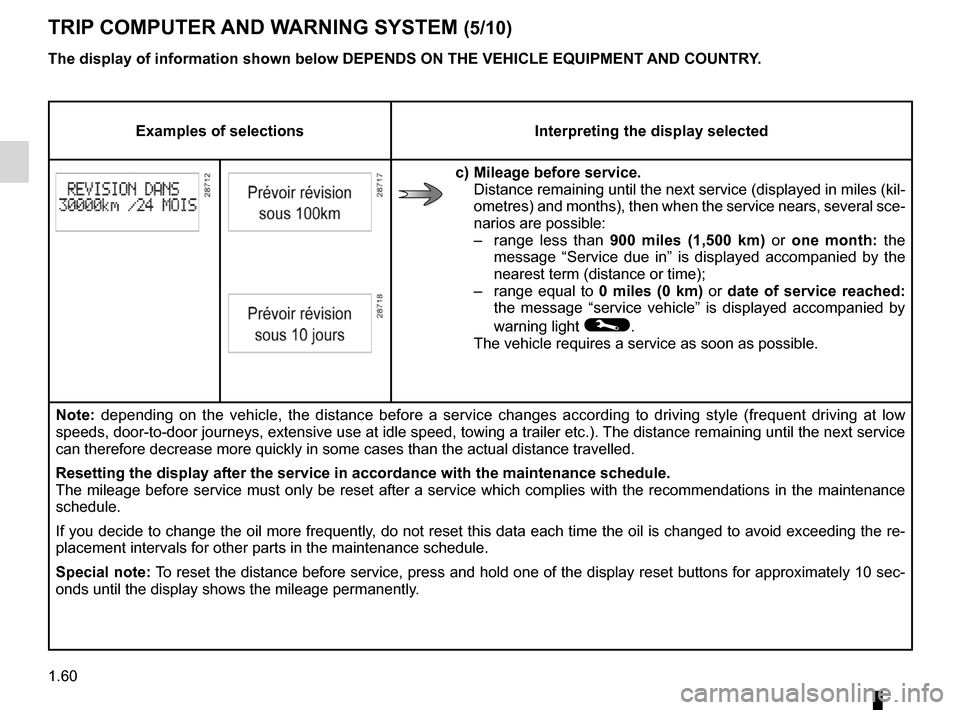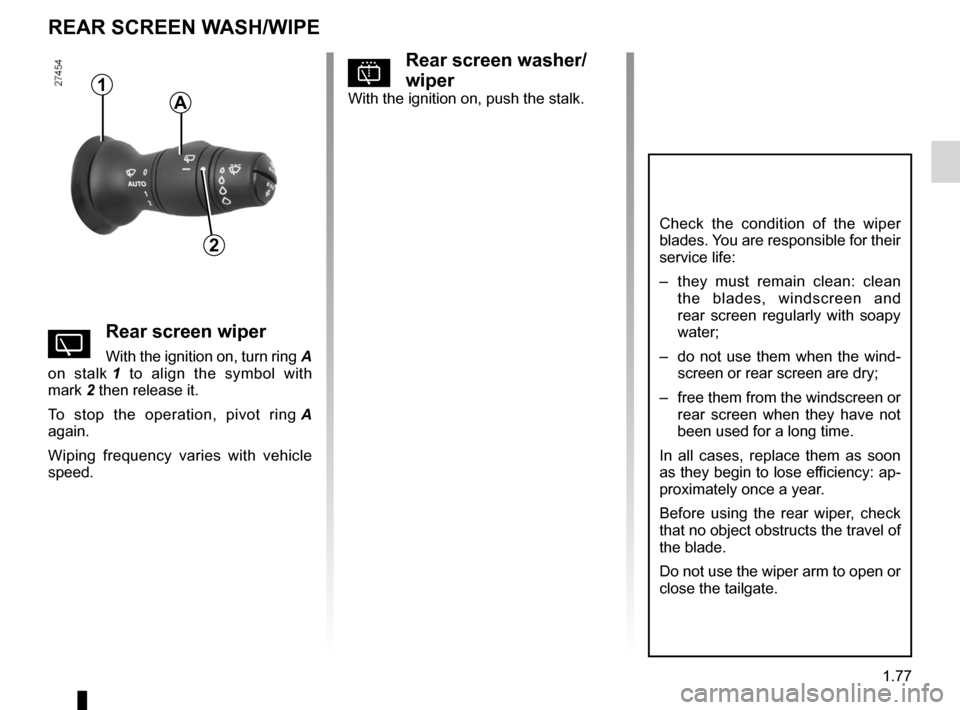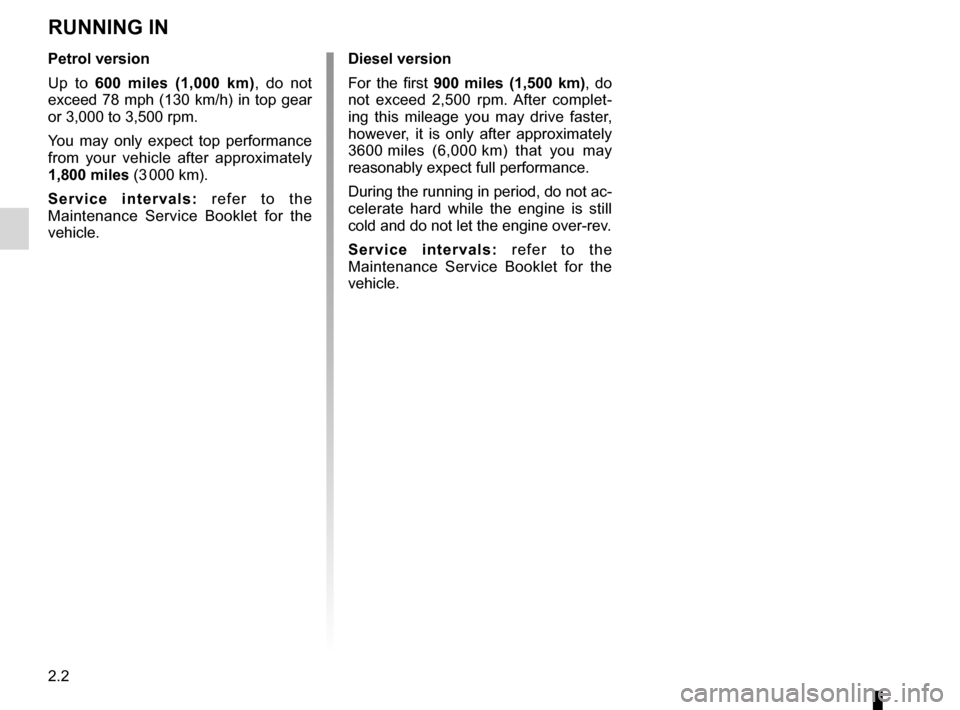2012 RENAULT MEGANE RS service
[x] Cancel search: servicePage 8 of 239

locking the doors .................................. (up to the end of the DU)
emergency key ..................................... (up to the end of the DU)
child safety ............................................................. (current page)
children (safety) ..................................................... (current page)
RENAULT card use .................................................. (up to the end of the DU)
1.2
ENG_UD6258_1
Cartes RENAULT : généralités (X95 - B95 - D95 - Renault)
ENG_NU_837-6_BDK95_Renault_1
Jaune NoirNoir texte
Range of the RENAULT cardThis varies according to the surround -
ings. It is important to make sure when
handling the RENAULT card that you
do not lock or unlock the doors by inad -
vertently pressing the buttons.
RENAULT cards: General information, use, deadlocking
RENAULT cARds: general information (1/2)
1 Unlocking the doors and tailgate.
2 Locking all doors and tailgate.
3 Switching on the lighting remotely.
4 Unlocking/locking the tailgate
5 Integrated key.
special note
The RENAULT “SERVICE” card, on
equipped vehicles, can be identified by
the word “SERVICE” engraved on the
card. Refer to the information on the
RENAULT “SERVICE” card in section
1.
The RENAULT card is used
for:
– locking/unlocking the doors and tail-
gate (doors, tailgate) and the fuel
filler flap (see the following pages);
– switching on the vehicle lighting re -
motely (refer to the following pages);
– depending on the vehicle, automati-
cally closing the electric windows
and sunroof remotely (see the infor-
mation on “Electric windows/Electric
sunroof” in Section 3);
– starting the engine; refer to the in -
formation on “Starting the engine” in
Section 2.
Battery lifeMake sure that the correct battery type
is being used, and that the battery is in
good condition and inserted correctly.
Its service life is approximately two
years: replace it when the message
“ Keycard battery low ” appears on the
instrument panel (refer to the informa -
tion on the “RENAULT card: battery" in
section 5).
driver’s responsibility
Never leave your vehicle
with the RENAULT card
inside and never leave a
child (or a pet) unsupervised, even
for a short while.
They may pose a risk to themselves
or to others by starting the engine,
activating equipment such as the
electric windows or by locking the
doors.
Risk of serious injury.
45123
When the battery is flat, you can
still lock/unlock and start your ve -
hicle. Refer to the information on
“Locking/unlocking the doors” in
Section 1 and “Starting the engine”
in Section 2.
Page 15 of 239

locking the doors .................................. (up to the end of the DU)
RENAULT card use .................................................. (up to the end of the DU)
1.9
ENG_UD18962_2
Carte RENAULT en mode restreint (X95 - B95 - D95 - Renault)
ENG_NU_837-6_BDK95_Renault_1
RENAULT cARd “sER vIcE”
If the vehicle is equipped with this
card, it can be identified by the word
“SERVICE” engraved on the card.
In certain situations, you may wish to
entrust your vehicle to a third party
(parking valet, mechanic, etc.) whilst
restricting its operation.
The RENAULT “SERVICE” card en -
ables the vehicle to be locked but only
allows the driver's door to be unlocked
and the engine to be started.Activation of the “sER vIcE”
mode.
Insert the RENAULT “SERVICE” card
into the card reader 4 . All the vehicle
opening elements lock (except the driv-
er’s door).
If they do not, with the engine switched
off, press button 1 (all the doors and
the tailgate lock, with the exception of
the driver’s door) or 2 (the entire vehi -
cle locks) on the RENAULT “SERVICE”
card.
T h e i n t e r i o r l o c k i n g / u n l o c k i n g
switch 3 is deactivated while the ve-
hicle is in use with the RENAULT
“SERVICE” card.
E a c h v e h i c l e o n l y h a s o n e
RENAULT “SERVICE” card.
When using a RENAULT “SERVICE”
card, the other cards retain all their
functions.
12
4
5
deactivation of the
“sER vIcE” mode
There are two possibilities:
– Press a button on the RENAULT
card (not the RENAULT “SERVICE”
card);
– start the engine with a RENAULT
card (not the RENAULT “SERVICE”
card). With the card in reader 4 ,
press button 5.
3
Page 19 of 239

JauneNoirNoir texte
1.13
ENG_UD11876_3
Verrouillage / Déverrouillage des portes (X95 - B95 - D95 - Renault)\
ENG_NU_837-6_BDK95_Renault_1
LOcKINg/UNLOcKINg THE dOORs (2/2)
Interior locking/unlocking
door control
Switch 4 controls the doors, tailgate
and, depending on the vehicle, the fuel
filler flap simultaneously.
If a door or the tailgate is open or not
closed properly, the doors and tailgate
lock/unlock quickly.
If transporting an object with the tail -
gate open, you can still lock the doors:
with the engine stopped, press and
hold switch 4 for more than five sec -
onds to lock the other doors.
Locking the doors without
the RENAULT card
For example, in the event of a dis -
charged battery or the RENAULT card
temporarily not working, etc.
With the engine switched off and a
door or tailgate open, press and hold
switch 4 for more than five seconds.
When the door is closed, all the doors
and the tailgate will be locked.
Unlocking the vehicle from the outside
is only possible with the RENAULT card
in the vehicle's access zone or using
the key integrated in the RENAULT
card.
door and tailgate status
indicator
When the ignition is on, the indicator
light integrated in switch 4 informs you
of the status of the doors and tailgate:
– indicator light on, the doors and tail-
gate are locked,
– indicator light off, the doors and tail-
gate are unlocked.
When you lock the doors, the indicator
light remains lit and then goes out.
Never leave your vehicle
with the RENAULT card
inside.
If you decide to keep the
doors locked when you are
driving, remember that it
may be more difficult for the
emergency services to gain access
to the passenger compartment in
the event of an emergency.
4
After locking/unlocking the vehicle
or the tailgate only using the but -
tons on the RENAULT card, remote
locking and unlocking in hands-free
mode are deactivated.
To reactivate the “hands-free” mode:
restart the vehicle.
Page 62 of 239

control instruments ............................... (up to the end of the DU)
indicators: instrument panel ............................. (up to the end of the DU)
trip computer and warning system ........(up to the end of the DU)
instrument panel ................................... (up to the end of the DU)
warning lights ........................................ (up to the end of the DU)
instrument panel messages ..................(up to the end of the DU)
1.56
ENG_UD18879_3
Ordinateur de bord (X95 - B95 - D95 - Renault)
ENG_NU_837-6_BDK95_Renault_1
Jaune NoirNoir texte
trip computer and warning system
TRIp cOmpUTER ANd WARNINg sYsTEm (1/10)
Trip computer and warning
system 1
Depending on the vehicle, this includes
the following functions:
– distance travelled;
– journey parameters;
– information messages;
– operating fault messages (con -
nected to the warning light
©);
– warning messages (connected to the
® warning light);
– v e h i c l e s e t t i n g s c u s t o m i s a t i o n
menu.
All these functions are described on the
following pages.
display selection keys 2
and 3
Scroll through the following information
upwards (button 2) or downwards (but-
ton 3 ) by pressing briefly and succes -
sively (the display depends on the vehi-
cle equipment and country).
a) total mileage and trip mileage re -
corder;
b) journey parameters:
– fuel used;
– average fuel consumption;
– current fuel consumption;
– estimated range;
– distance travelled;
– average speed;
1
2
3
c) mileage before service;
d) tyre pressure monitor;
e) vehicle settings customisation menu;
f) trip log, operating faults and informa-
tion message readout.
Page 66 of 239

1.60
ENG_UD18879_3
Ordinateur de bord (X95 - B95 - D95 - Renault)
ENG_NU_837-6_BDK95_Renault_1
Jaune NoirNoir texte
TRIp cOmpUTER ANd WARNINg sYsTEm (5/10)
Examples of selections Interpreting the display selected
c) mileage before service.
Distance remaining until the next service (displayed in miles (kil-
ometres) and months), then when the service nears, several sce-
narios are possible:
– range less than 900 miles (1,500 km) or one month: the
message “Service due in” is displayed accompanied by the
nearest term (distance or time);
– range equal to 0 miles (0 km) or date of service reached:
the message “service vehicle” is displayed accompanied by
warning light
©.
The vehicle requires a service as soon as possible.
Note: depending on the vehicle, the distance before a service changes according to driving style (frequent driving at low
speeds, door-to-door journeys, extensive use at idle speed, towing a trailer etc.). The distance remaining until the next service
can therefore decrease more quickly in some cases than the actual distan\
ce travelled.
Resetting the display after the service in accordance with the maintenan\
ce schedule.
The mileage before service must only be reset after a service which complies with the recommendations in the maintenance
schedule.
If you decide to change the oil more frequently, do not reset this data each time the oil is changed to avoid exceeding the re-
placement intervals for other parts in the maintenance schedule.
special note: To reset the distance before service, press and hold one of the display reset buttons for approximately 10 sec-
onds until the display shows the mileage permanently.
The display of information shown below dEpENds ON THE vEHIcLE EQUIpmENT ANd cOUNTRY.
Page 83 of 239

screen wash/wipe ................................. (up to the end of the DU)
windscreen washer ............................... (up to the end of the DU)
wipers ................................................... (up to the end of the DU)
1.77
ENG_UD11879_3
Essuie-vitre / lave-vitre arrière (X95 - B95 - D95 - Renault)
ENG_NU_837-6_BDK95_Renault_1
REAR scREEN WAsH/WIpE
1
2
Check the condition of the wiper
blades. You are responsible for their
service life:
– they must remain clean: clean
the blades, windscreen and
rear screen regularly with soapy
water;
– do not use them when the wind -
screen or rear screen are dry;
– free them from the windscreen or
rear screen when they have not
been used for a long time.
In all cases, replace them as soon
as they begin to lose efficiency: ap-
proximately once a year.
Before using the rear wiper, check
that no object obstructs the travel of
the blade.
Do not use the wiper arm to open or
close the tailgate.
pRear screen washer/
wiper
With the ignition on, push the stalk.
YRear screen wiper
With the ignition on, turn ring A
on stalk 1 to align the symbol with
mark 2 then release it.
To stop the operation, pivot ring A
again.
Wiping frequency varies with vehicle
speed.
A
Page 88 of 239

running in .............................................. (up to the end of the DU)
driving ................................................... (up to the end of the DU)
2.2
ENG_UD10078_2
Rodage (X91 - B91 - K91 - X95 - J95 - R95 - Renault)
ENG_NU_837-6_BDK95_Renault_2
Running in
RUNNING IN
Petrol version
Up to 600 miles (1,000 km) , do not
exceed 78 mph (130 km/h) in top gear
or 3,000 to 3,500 rpm.
You may only expect top performance
from your vehicle after approximately
1,800 miles (3 000 km).
S e r v i c e i n t e r v a l s : r e f e r t o t h e
Maintenance Service Booklet for the
vehicle. Diesel version
For the first
900 miles (1,500 km), do
not exceed 2,500 rpm. After complet -
ing this mileage you may drive faster,
however, it is only after approximately
3600 miles (6,000 km) that you may
reasonably expect full performance.
During the running in period, do not ac-
celerate hard while the engine is still
cold and do not let the engine over-rev.
S e r v i c e i n t e r v a l s : r e f e r t o t h e
Maintenance Service Booklet for the
vehicle.
Page 92 of 239

special features of petrol vehicles ........ (up to the end of the DU)
catalytic converter ................................. (up to the end of the DU)
driving ................................................... (up to the end of the DU)
catalytic converter ................................. (up to the end of the DU)
2.6
ENG_UD10553_1
Particularités des versions essence (X85 - B85 - C85 - S85 - K85 - R\
enault)
ENG_NU_837-6_BDK95_Renault_2
Special features of petrol versions
SPECIAL FEATURES OF PETROL VERSIONS
The following operating conditions:
– driving for long periods when the low
fuel level warning light is lit;
– using leaded petrol;
– using fuel or lubrication additives
which are not approved.
Or operating faults such as:
– faulty ignition system, running out of
fuel or disconnected spark plugs re-
sulting in the engine misfiring or cut-
ting out when driving;
– loss of power,
as they may cause the catalytic con -
verter to overheat and thus reduce its
efficiency, or damage it irreparably
and cause heat damage to the vehi-
cle. If you notice any of the above operating
faults, have the necessary repairs car-
ried out as soon as possible by an ap-
proved Dealer.
These faults may be avoided by regu
-
larly taking your vehicle to an approved
Dealer at the intervals specified in the
Maintenance Service Booklet.
Starting problems
To avoid damaging the catalytic con -
verter, do not keep trying to start the
engine (using the start button, or by
pushing or towing the vehicle) without
having identified and corrected the
starting fault.
If the fault cannot be identified, do not
keep trying to start the engine, but con-
tact an approved Dealer.
Do not park the vehicle or
run the engine in locations
where combustible sub -
stances or materials such as
grass or leaves can come into con-
tact with the hot exhaust system.